fuel cap TOYOTA PRIUS V 2017 ZVW40 / 1.G Owners Manual
[x] Cancel search | Manufacturer: TOYOTA, Model Year: 2017, Model line: PRIUS V, Model: TOYOTA PRIUS V 2017 ZVW40 / 1.GPages: 624, PDF Size: 13.82 MB
Page 3 of 624
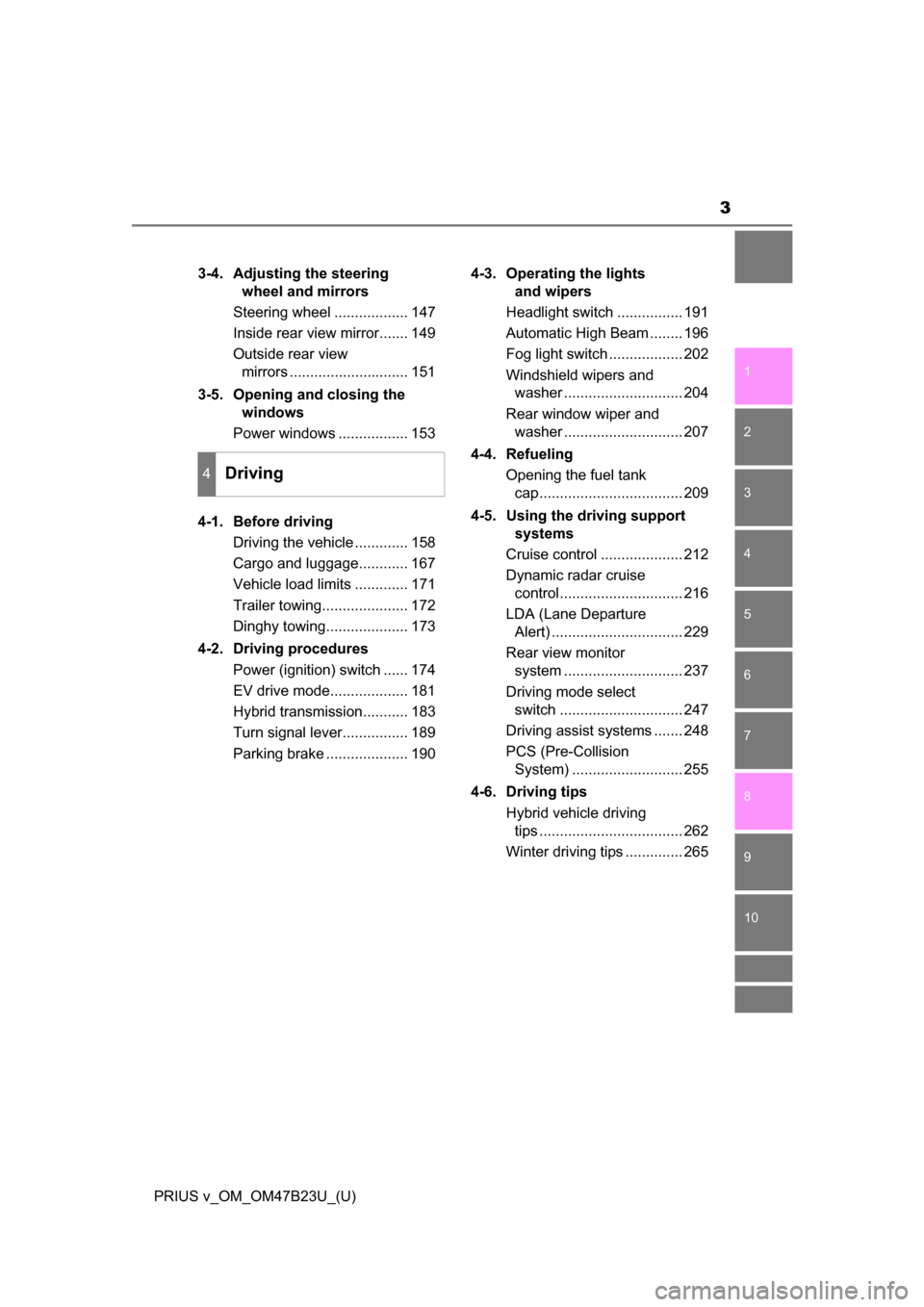
3
1
9 8
7
6 4 3
2
PRIUS v_OM_OM47B23U_(U)
10
5
3-4. Adjusting the steering wheel and mirrors
Steering wheel .................. 147
Inside rear view mirror....... 149
Outside rear view mirrors ............................. 151
3-5. Opening and closing the windows
Power windows ................. 153
4-1. Before driving Driving the vehicle ............. 158
Cargo and luggage............ 167
Vehicle load limits ............. 171
Trailer towing..................... 172
Dinghy towing.................... 173
4-2. Driving procedures Power (ignition) switch ...... 174
EV drive mode................... 181
Hybrid transmission........... 183
Turn signal lever................ 189
Parking brake .................... 190 4-3. Operating the lights
and wipers
Headlight switch ................ 191
Automatic High Beam ........ 196
Fog light switch .................. 202
Windshield wipers and washer ............................. 204
Rear window wiper and washer ............................. 207
4-4. Refueling Opening the fuel tank cap................................... 209
4-5. Using the driving support systems
Cruise control .................... 212
Dynamic radar cruise control.............................. 216
LDA (Lane Departure Alert) ................................ 229
Rear view monitor system ............................. 237
Driving mode select switch .............................. 247
Driving assist systems ....... 248
PCS (Pre-Collision System) ........................... 255
4-6. Driving tips Hybrid vehicle driving tips ................................... 262
Winter driving tips .............. 265
4Driving
Page 17 of 624
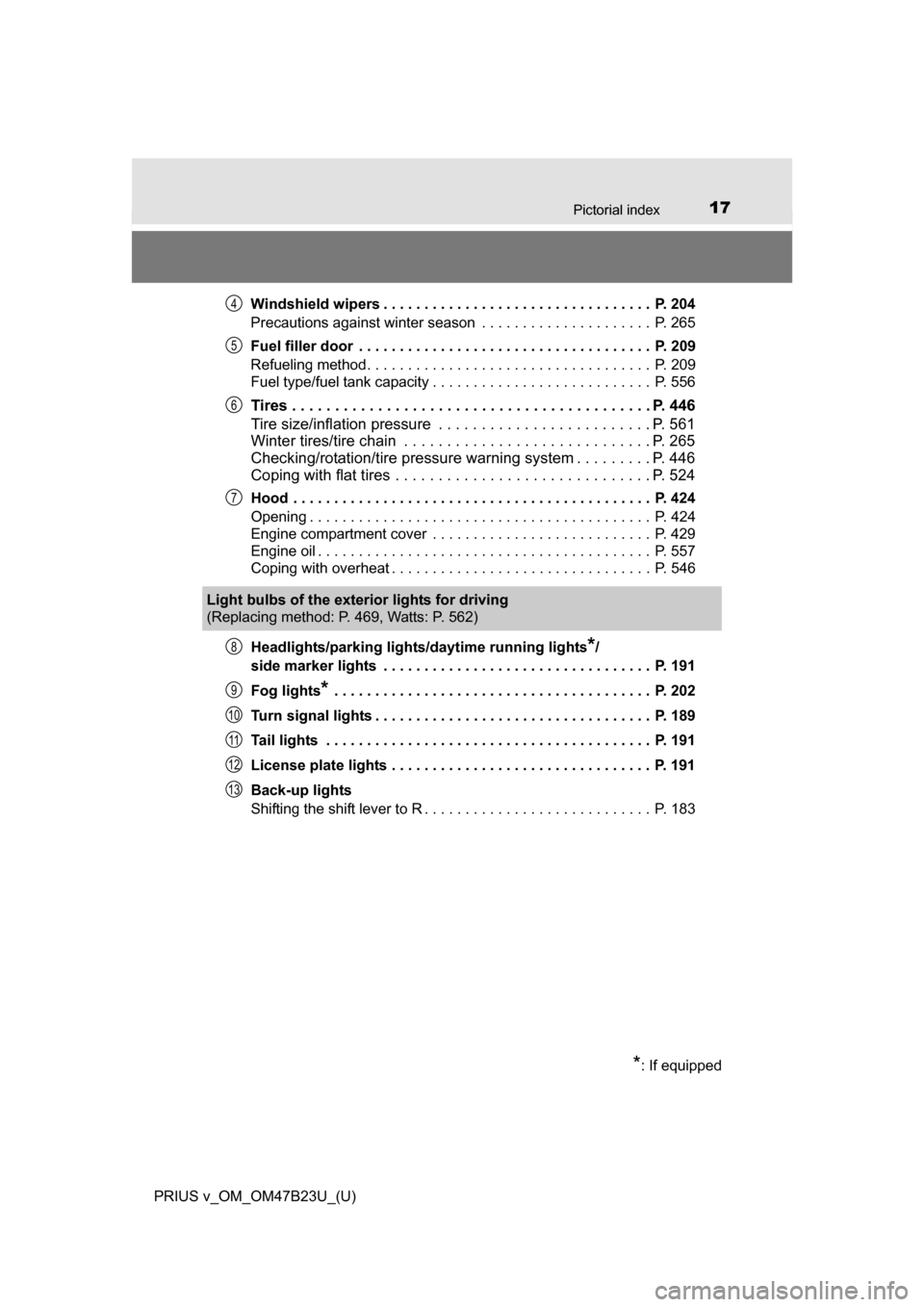
17Pictorial index
PRIUS v_OM_OM47B23U_(U)Windshield wipers . . . . . . . . . . . . . . . . . . . . . . . . . . . . . . . . . P. 204
Precautions against winter season . . . . . . . . . . . . . . . . . . . . . P. 265
Fuel filler door . . . . . . . . . . . . . . . . . . . . . . . . . . . . . . . . . . . . P. 209
Refueling method. . . . . . . . . . . . . . . . . . . . . . . . . . . . . . . . . . . P. 209
Fuel type/fuel tank capacity . . . . . . . . . . . . . . . . . . . . . . . . . . . P. 556
Tires . . . . . . . . . . . . . . . . . . . . . . . . . . . . . . . . . . . . . . . . . . P. 446
Tire size/inflation pressure . . . . . . . . . . . . . . . . . . . . . . . . . P. 561
Winter tires/tire chain . . . . . . . . . . . . . . . . . . . . . . . . . . . . . P. 265
Checking/rotation/tire pressure warning system . . . . . . . . . P. 446
Coping with flat tires . . . . . . . . . . . . . . . . . . . . . . . . . . . . . . P. 524
Hood . . . . . . . . . . . . . . . . . . . . . . . . . . . . . . . . . . . . . . . . . . . . P. 424
Opening . . . . . . . . . . . . . . . . . . . . . . . . . . . . . . . . . . . . . . . . . . P. 424
Engine compartment cover . . . . . . . . . . . . . . . . . . . . . . . . . . . P. 429
Engine oil . . . . . . . . . . . . . . . . . . . . . . . . . . . . . . . . . . . . . . . . . P. 557
Coping with overheat . . . . . . . . . . . . . . . . . . . . . . . . . . . . . . . . P. 546
Headlights/parking lights/
daytime running lights
*/
side marker lights . . . . . . . . . . . . . . . . . . . . . . . . . . . . . . . . . P. 191
Fog lights
* . . . . . . . . . . . . . . . . . . . . . . . . . . . . . . . . . . . . . . . P. 202
Turn signal lights . . . . . . . . . . . . . . . . . . . . . . . . . . . . . . . . . . P. 189
Tail lights . . . . . . . . . . . . . . . . . . . . . . . . . . . . . . . . . . . . . . . . P. 191
License plate lights . . . . . . . . . . . . . . . . . . . . . . . . . . . . . . . . P. 191
Back-up lights
Shifting the shift lever to R . . . . . . . . . . . . . . . . . . . . . . . . . . . . P. 183
4
5
6
7
Light bulbs of the exterior lights for driving
(Replacing method: P. 469, Watts: P. 562)
*: If equipped
8
9
10
11
12
13
Page 157 of 624

157
PRIUS v_OM_OM47B23U_(U)
4Driving
4-1. Before drivingDriving the vehicle ............. 158
Cargo and luggage ........... 167
Vehicle load limits ............. 171
Trailer towing..................... 172
Dinghy towing ................... 173
4-2. Driving procedures Power (ignition) switch ...... 174
EV drive mode .................. 181
Hybrid transmission........... 183
Turn signal lever................ 189
Parking brake .................... 190 4-3. Operating the lights
and wipers
Headlight switch ................ 191
Automatic High Beam ....... 196
Fog light switch ................. 202
Windshield wipers and washer ............................ 204
Rear window wiper and washer ............................ 207
4-4. Refueling Opening the fuel tank cap .................................. 209
4-5. Using the driving support systems
Cruise control .................... 212
Dynamic radar cruise control ............................. 216
LDA (Lane Departure Alert) ............................... 229
Rear view monitor system ............................ 237
Driving mode select switch .............................. 247
Driving assist systems ...... 248
PCS (Pre-Collision System) ........................... 255
4-6. Driving tips Hybrid vehicle driving tips .................................. 262
Winter driving tips ............. 265
Page 209 of 624
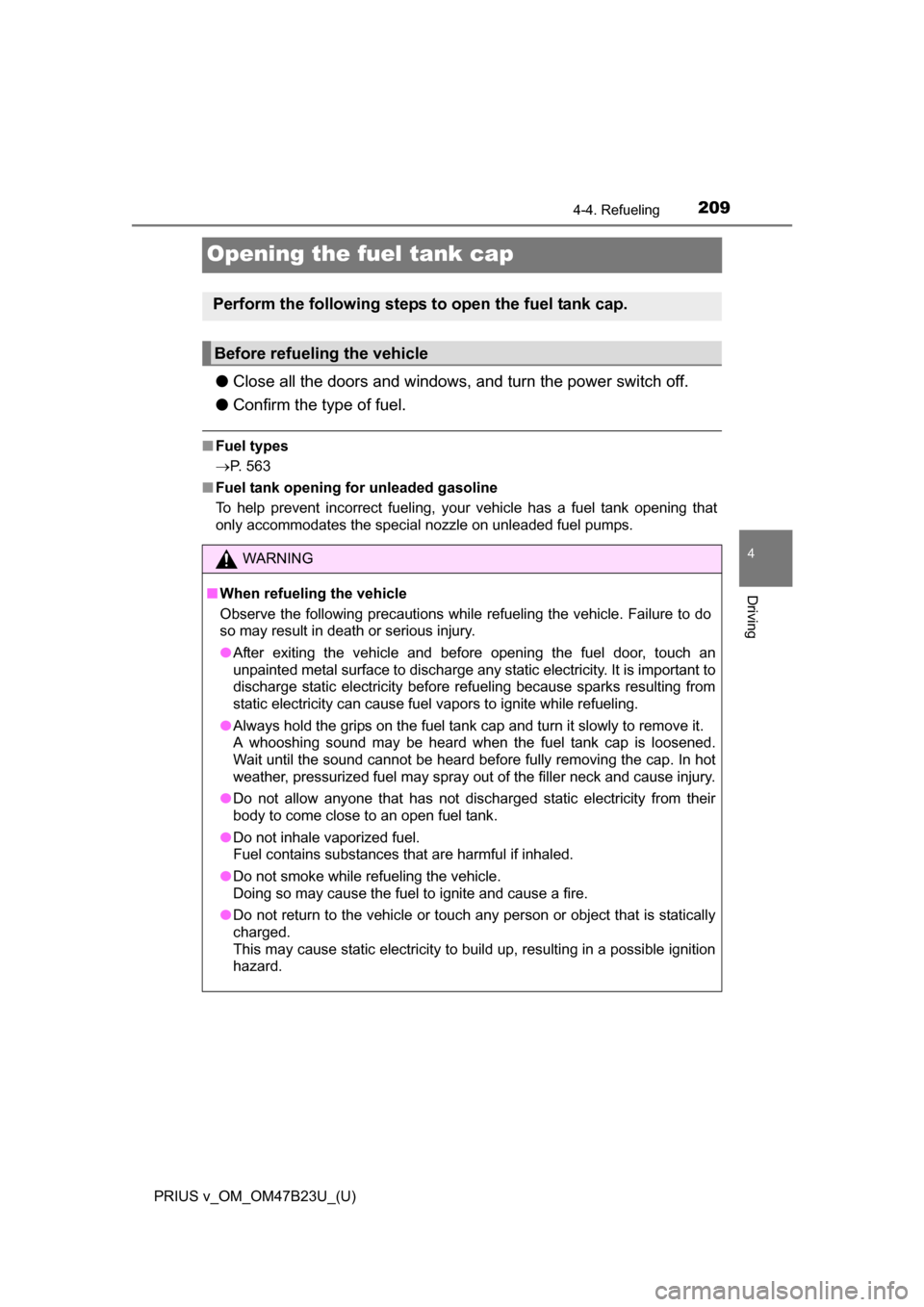
209
PRIUS v_OM_OM47B23U_(U)
4-4. Refueling
4
Driving
Opening the fuel tank cap
●Close all the doors and windows, and turn the power switch off.
● Confirm the type of fuel.
■Fuel types
P. 563
■ Fuel tank opening for unleaded gasoline
To help prevent incorrect fueling, your vehicle has a fuel tank opening that
only accommodates the special nozzle on unleaded fuel pumps.
Perform the following steps to open the fuel tank cap.
Before refueling the vehicle
WARNING
■When refueling the vehicle
Observe the following precautions while refueling the vehicle. Failure to do
so may result in death or serious injury.
●After exiting the vehicle and before opening the fuel door, touch an
unpainted metal surface to discharge any static electricity. It is important to
discharge static electricity before refueling because sparks resulting from
static electricity can cause fuel vapors to ignite while refueling.
● Always hold the grips on the fuel tank cap and turn it slowly to remove it.
A whooshing sound may be heard when the fuel tank cap is loosened.
Wait until the sound cannot be heard before fully removing the cap. In hot
weather, pressurized fuel may spray out of the filler neck and cause injury.
● Do not allow anyone that has not discharged static electricity from their
body to come close to an open fuel tank.
● Do not inhale vaporized fuel.
Fuel contains substances that are harmful if inhaled.
● Do not smoke while refueling the vehicle.
Doing so may cause the fuel to ignite and cause a fire.
● Do not return to the vehicle or touch any person or object that is statically
charged.
This may cause static electricity to build up, resulting in a possible ignition
hazard.
Page 210 of 624
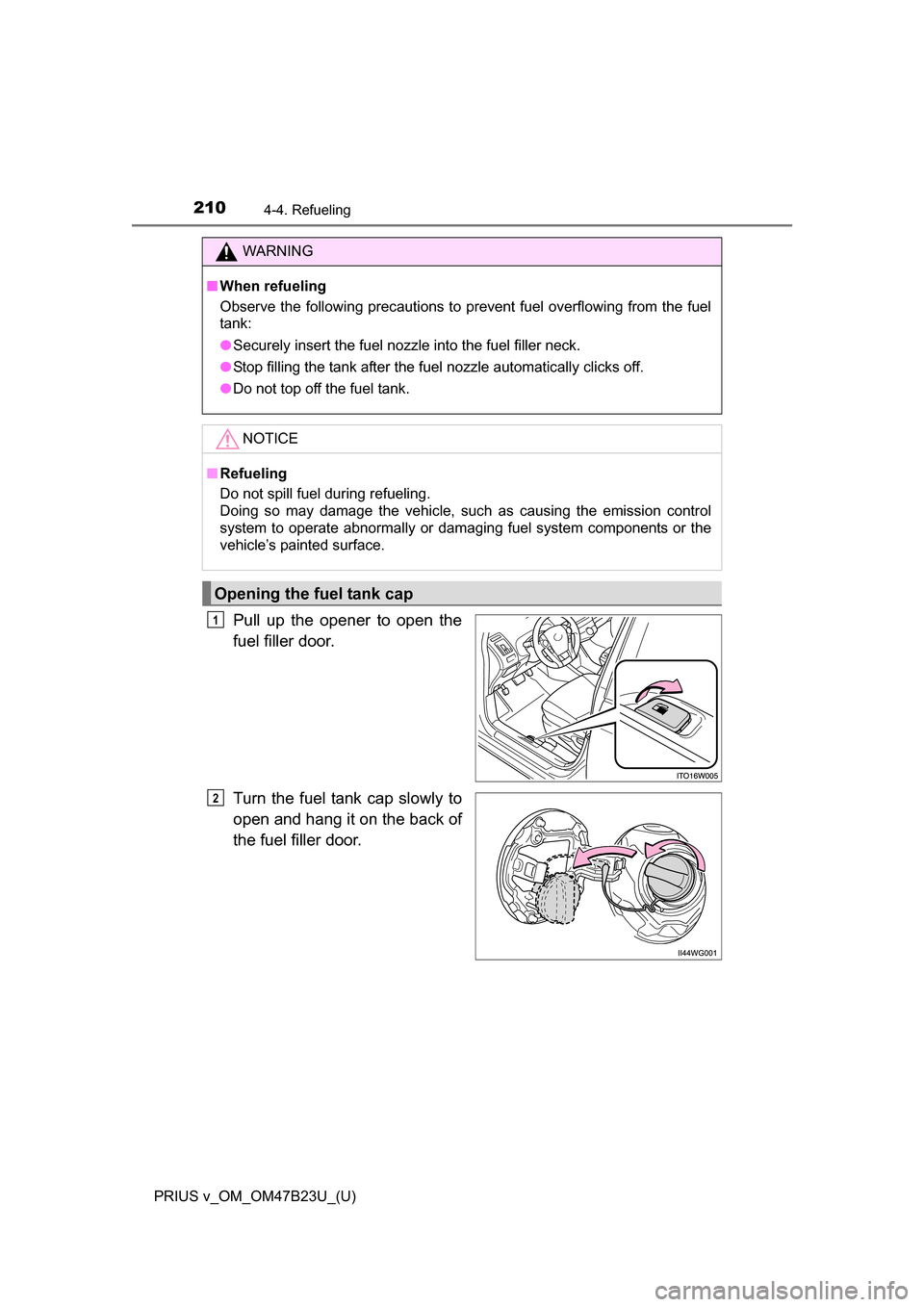
210
PRIUS v_OM_OM47B23U_(U)
4-4. Refueling
Pull up the opener to open the
fuel filler door.
Turn the fuel tank cap slowly to
open and hang it on the back of
the fuel filler door.
WARNING
■When refueling
Observe the following precautions to prevent fuel overflowing from the fuel
tank:
●Securely insert the fuel nozzle into the fuel filler neck.
● Stop filling the tank after the fuel nozzle automatically clicks off.
● Do not top off the fuel tank.
NOTICE
■Refueling
Do not spill fuel during refueling.
Doing so may damage the vehicle, such as causing the emission control
system to operate abnormally or damaging fuel system components or the
vehicle’s painted surface.
Opening the fuel tank cap
1
2
Page 211 of 624
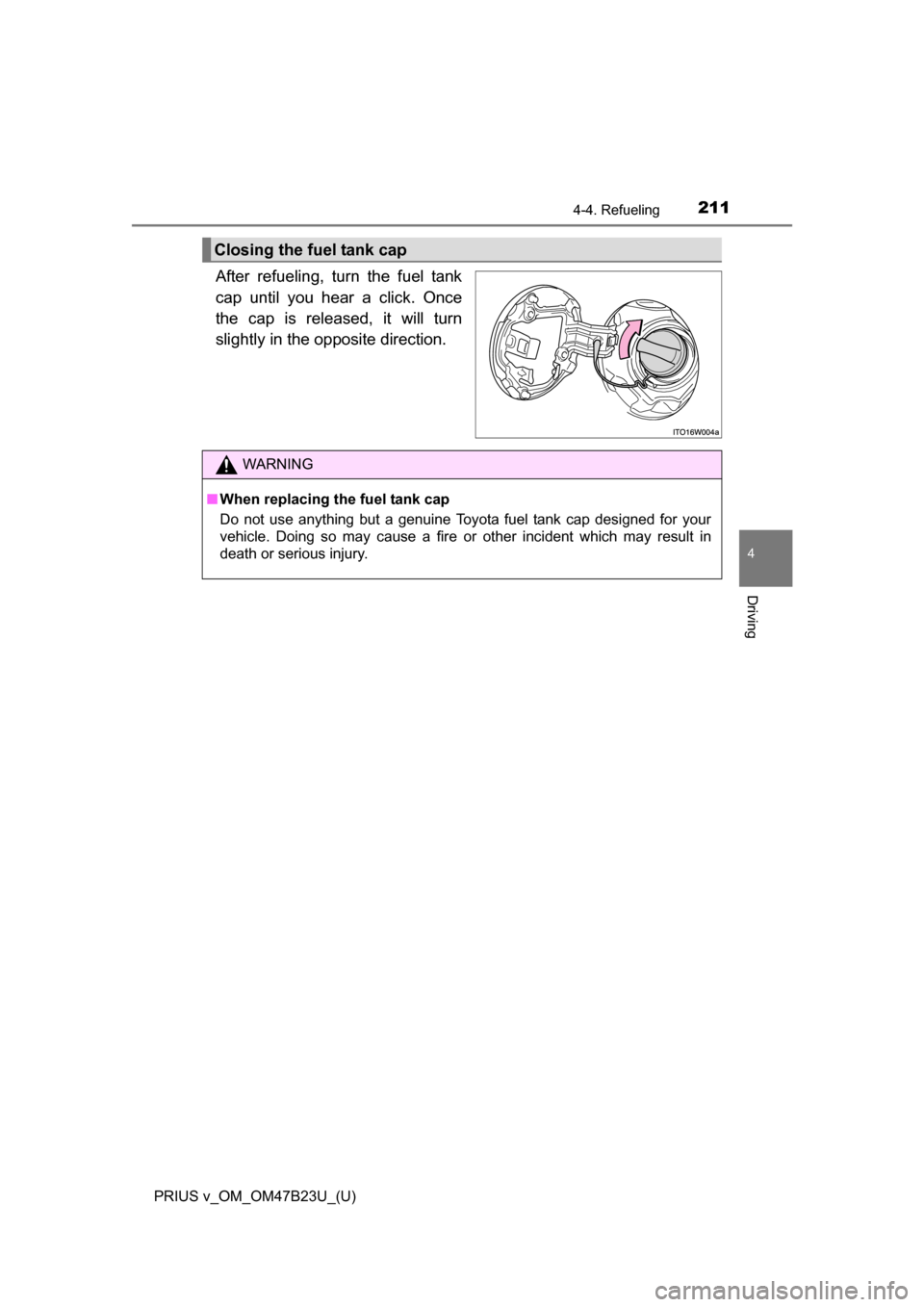
PRIUS v_OM_OM47B23U_(U)
2114-4. Refueling
4
Driving
After refueling, turn the fuel tank
cap until you hear a click. Once
the cap is released, it will turn
slightly in the opposite direction.
Closing the fuel tank cap
WARNING
■When replacing the fuel tank cap
Do not use anything but a genuine Toyota fuel tank cap designed for your
vehicle. Doing so may cause a fire or other incident which may result in
death or serious injury.
Page 281 of 624

281
PRIUS v_OM_OM47B23U_(U)
5-2. Setup
5
Audio system
General settings
Press the “SETUP” button.
Select “General” on the “Setup”
screen.“English”, “Français” or
“Español” can be selected.
Select to change the unit of
measure for distance dis-
tance/fuel consumption. (If
equipped)
On/off can be selected to
sound beeps.
Select to change the screen
color.
Select to change the keyboard layout.
Select to change the capacitive touch button sensor sensitivity.
The animation effect for the screen can be set to on/off.
Select to delete personal data. ( P. 282)
Select to update program versions. For details, contact your
Toyota dealer.
Select to display the software info rmation. Notices related to third
party software used in this pr oduct are enlisted. (This includes
instructions for obtaining such software, where applicable.)
■ To return to the default settings
Select “Default”, and then “Yes”.
Settings are available for adjusting the operation sounds,
screen animation, etc.
Screen for general settings
1
2
1
2
3
4
5
6
7
8
9
10
Page 371 of 624
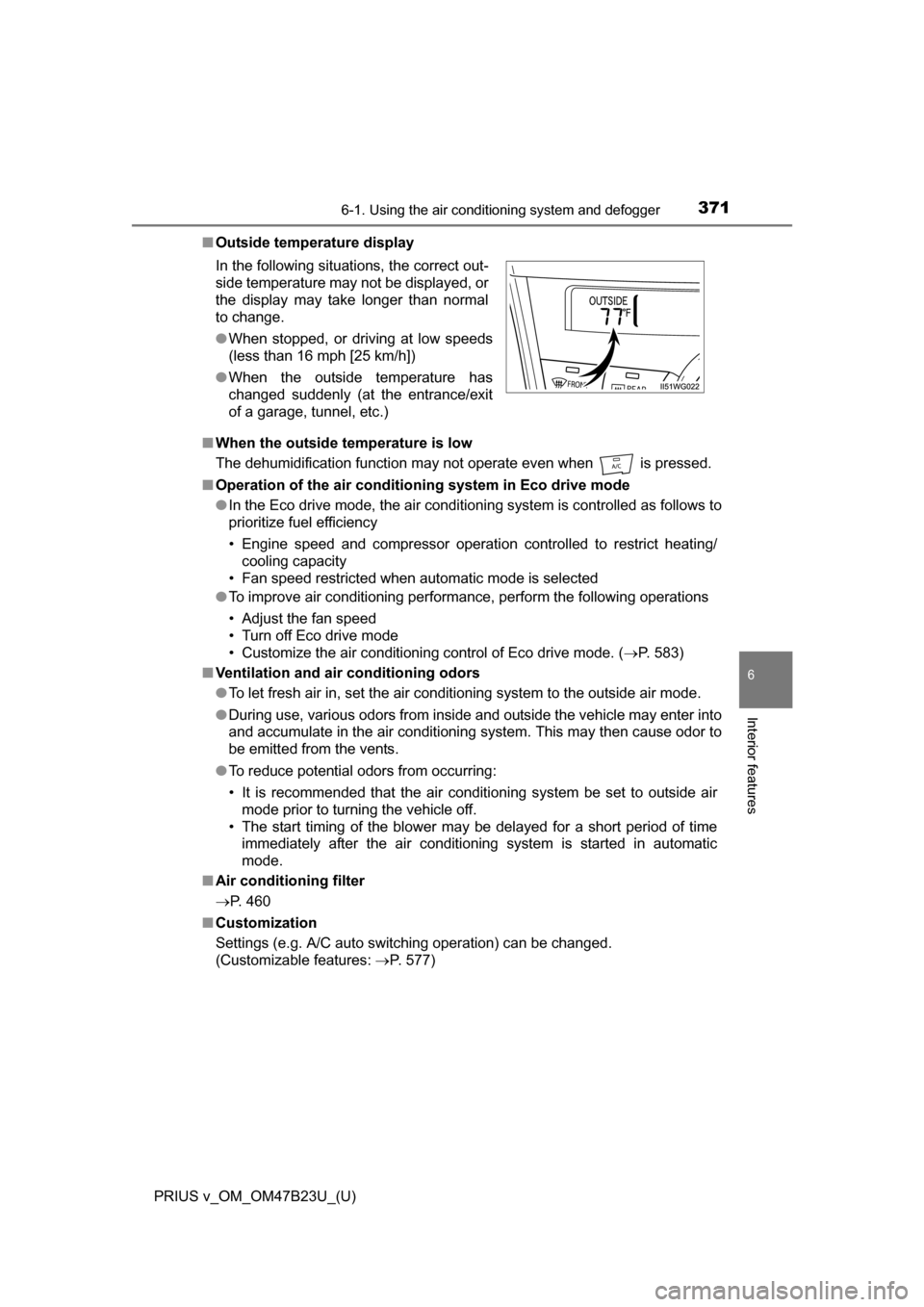
PRIUS v_OM_OM47B23U_(U)
3716-1. Using the air conditioning system and defogger
6
Interior features
■Outside temperature display
■ When the outside temperature is low
The dehumidification function may not operate even when is pressed.
■ Operation of the air conditioning system in Eco drive mode
●In the Eco drive mode, the air conditioning system is controlled as follows to
prioritize fuel efficiency
• Engine speed and compressor operation controlled to restrict heating/
cooling capacity
• Fan speed restricted when automatic mode is selected
● To improve air conditioning performance, perform the following operations
• Adjust the fan speed
• Turn off Eco drive mode
• Customize the air conditioning control of Eco drive mode. ( P. 583)
■ Ventilation and air conditioning odors
●To let fresh air in, set the air conditioning system to the outside air mode.
● During use, various odors from inside and outside the vehicle may enter into
and accumulate in the air conditioning system. This may then cause odor to
be emitted from the vents.
● To reduce potential odors from occurring:
• It is recommended that the air conditioning system be set to outside air
mode prior to turning the vehicle off.
• The start timing of the blower may be delayed for a short period of time immediately after the air conditioning system is started in automatic
mode.
■ Air conditioning filter
P. 460
■ Customization
Settings (e.g. A/C auto switching operation) can be changed.
(Customizable features: P. 577)
In the following situations, the correct out-
side temperature may not be displayed, or
the display may take longer than normal
to change.
●
When stopped, or driving at low speeds
(less than 16 mph [25 km/h])
● When the outside temperature has
changed suddenly (at the entrance/exit
of a garage, tunnel, etc.)
Page 421 of 624

421
PRIUS v_OM_OM47B23U_(U)
7-2. Maintenance
7
Maintenance and care
Emission inspection and maintenance (I/M)
programs
The OBD system determines that a problem exists somewhere in the
emission control system. Your vehicl e may not pass the I/M test and
may need to be repaired. Contact your Toyota dealer to service the
vehicle.
● When the 12-volt battery is disconnected or discharged
Readiness codes that are set duri ng ordinary driving are erased.
Also, depending on your driving habits, the readiness codes may
not be completely set.
● When the fuel tank cap is loose
The malfunction indicator lamp comes on indicating a temporary
malfunction and your vehicle may not pass the I/M test.
The error code in the OBD system will not be cleared unless the vehi-
cle is driven 40 or more times.
Contact your Toyota dealer to prepare the vehicle for re-testing.
Some states have vehicle emission inspection programs which
include OBD (On Board Diagnos tics) checks. The OBD system
monitors the operation of the emission control system.
If the malfunction indicator lamp comes on
Your vehicle may not pass the I/M test in the following situations:
When the malfunction indicator lamp still remains on after sev-
eral driving trips
If your vehicle does not pass the I/M test
Page 456 of 624
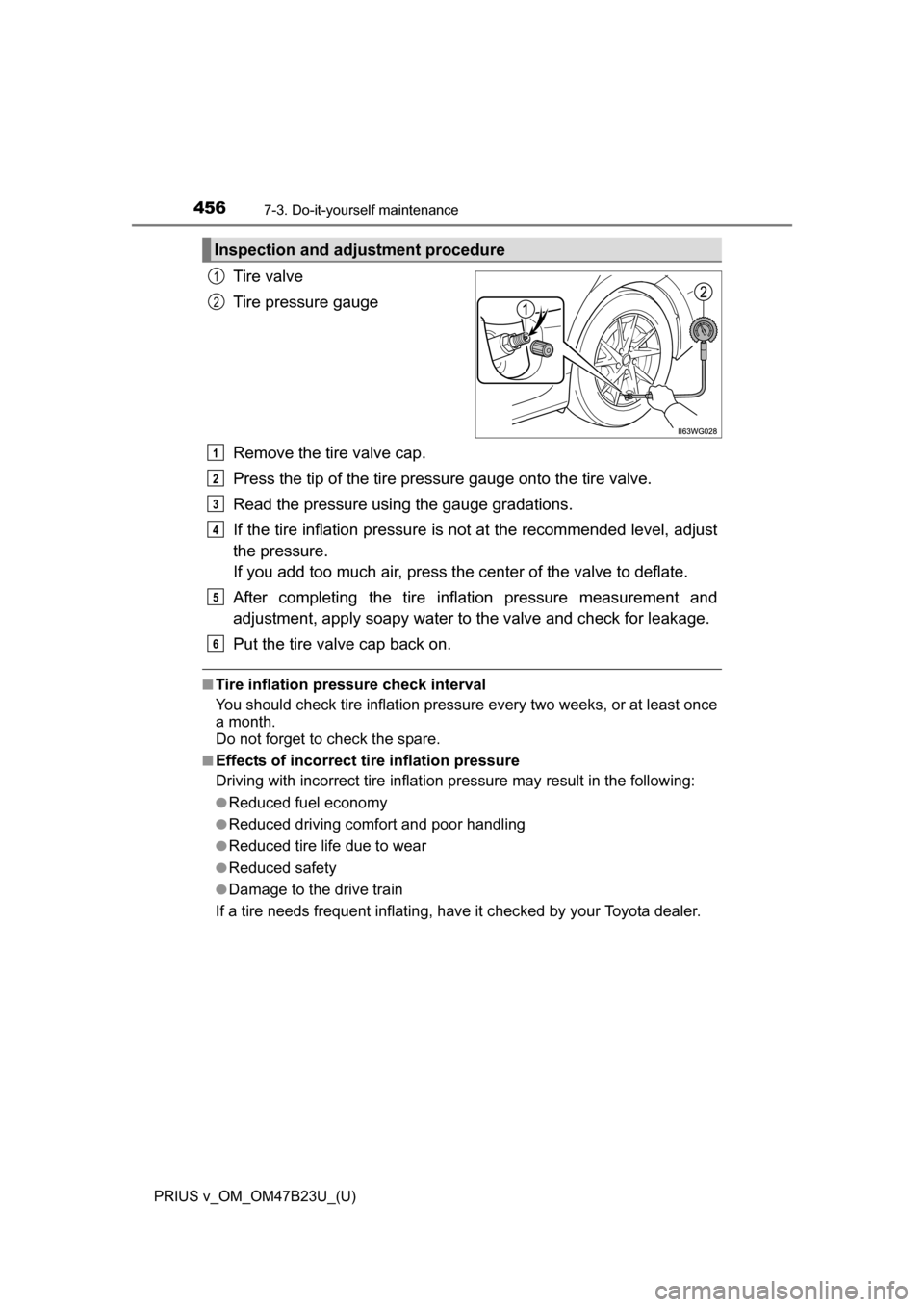
456
PRIUS v_OM_OM47B23U_(U)
7-3. Do-it-yourself maintenance
Tire valve
Tire pressure gauge
Remove the tire valve cap.
Press the tip of the tire pressure gauge onto the tire valve.
Read the pressure usi ng the gauge gradations.
If the tire inflation pressure is not at the recommended level, adjust
the pressure.
If you add too much air, press the center of the valve to deflate.
After completing the tire inflation pressure measurement and
adjustment, apply soapy water to the valve and check for leakage.
Put the tire valve cap back on.
■Tire inflation pressure check interval
You should check tire inflation pressure every two weeks, or at least once
a month.
Do not forget to check the spare.
■Effects of incorrect tire inflation pressure
Driving with incorrect tire inflation pressure may result in the following:
●Reduced fuel economy
●Reduced driving comfort and poor handling
●Reduced tire life due to wear
●Reduced safety
●Damage to the drive train
If a tire needs frequent inflating, have it checked by your Toyota dealer.
Inspection and adjustment procedure
1
2
1
2
3
4
5
6